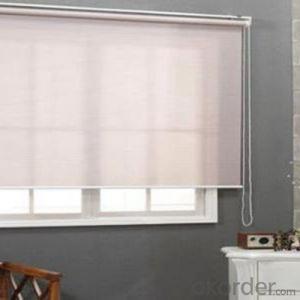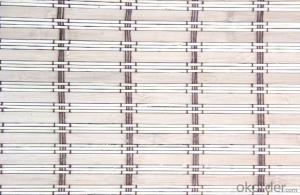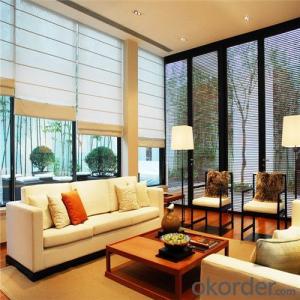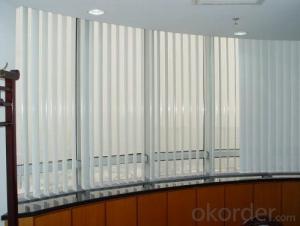office sunsreen and blackout roller curtain
- Loading Port:
- China main port
- Payment Terms:
- TT OR LC
- Min Order Qty:
- 1 roll
- Supply Capability:
- 10000 roll/month
OKorder Service Pledge
OKorder Financial Service
You Might Also Like
Specification
Product Description
Product Overviews
Brand Name | CNBM | |
Fabric | roller type vertical window shade blackout sunscreen fabric | |
Fabric composition | 30% polyester 70% vinyl-coated polyester yarns | |
Fabric openness | 0,1%,3%,4%,5%,12% | |
| Fireproof level | B2 | |
| Light fastness | 5-6 grade (AS2001.4) | |
| Fabric thickness | 0.6mm-1.1mm | |
Fabric color | white, black, grey, beige, off white etc. | |
| Size | customized | |
Pattern | vertical | |
Operation System | Manual / Motorized(110V & 220V motor) | |
Head Rail | 38mm Aluminum tube with anodic oxidation treatment surface | |
Blinds Shape | Roller blinds | |
UOM | sets | |
Packing | hard paper cylinder standard export package | |
MOQ | 10 sets | |
Payment Terms | T/T,Western Union | |
Delivery Time | 1-15 working days as the payment is confirmed | |
Character of the product
1. Sunscreen fabric is widely used at indoor & outdoor for roller blinds and canopy
2. has good quality of sunshade /waterproof /fireproof /UV-anti /fungi-proofing
3. It has 0~12% openness which you can see outdoor scenery through the fabric
4. Easy clean & Easy install
About our company:


- Q: Can I use curtains on high windows?
- Yes, curtains can be used on high windows. However, it may be more practical to use long curtains that can be easily reached or opt for curtain rods that can be extended to accommodate the height of the window.
- Q: Can I use curtains on a sliding glass door?
- Yes, you can use curtains on a sliding glass door.
- Q: Can I use curtains on French doors?
- Absolutely, curtains can certainly be used on French doors. They make an excellent addition to French doors because they offer privacy, introduce a stylish element, and assist in regulating the amount of light entering the room. French doors offer a variety of options for curtain styles, including sheer curtains, blackout curtains, and decorative drapes. It is important to select curtains that are the correct length and width to properly fit the doors. Moreover, utilizing curtain rods or tracks specifically designed for French doors will guarantee a secure and seamless operation of the curtains.
- Q: Can I use curtains on round windows?
- Yes, you can use curtains on round windows. There are several options available for dressing round windows with curtains. One option is to use a curved curtain rod that is specifically designed for round windows. This allows you to hang curtains in a traditional manner, creating a stylish and functional window treatment. Another option is to use circular curtains that are specifically designed to fit round windows. These curtains are typically made of flexible materials that can easily be adjusted to fit the shape of the window. Additionally, you can also consider using blinds or shades that are designed for round windows, which can provide privacy and light control. Overall, with the right curtain rod or specialized curtains, you can definitely use curtains on round windows to enhance the aesthetic appeal and functionality of your space.
- Q: How do I choose the right curtain fabric for a country decor theme?
- When choosing curtain fabric for a country decor theme, it is important to consider a few key factors. Firstly, opt for natural and rustic materials such as cotton, linen, or burlap, as they perfectly complement the cozy and warm ambiance of a country theme. Secondly, focus on selecting patterns and colors that evoke a rustic and charming feel, such as floral prints, gingham, or plaid designs. Lastly, ensure that the fabric you choose is durable and easy to maintain, as country decor often embraces a lived-in and relaxed atmosphere.
- Q: Can I use curtains to create a tropical-inspired space?
- Certainly, curtains can be utilized to fashion a space that emanates a tropical ambiance. These draperies offer an excellent means of infusing a room with color, texture, and pattern, all of which are crucial components in establishing a tropical motif. In order to achieve a space that exudes a tropical vibe, one may opt for curtains in vivacious hues such as teal, coral, or tropical green. It would be advantageous to seek out curtains adorned with botanical prints, palm fronds, or tropical blossoms, as these designs will undoubtedly heighten the tropical atmosphere. Furthermore, it may be prudent to consider employing curtains crafted from natural materials like bamboo or jute, as this will introduce a touch of exotic allure and textural variation. To fully encapsulate the overarching theme, it is advisable to combine the tropical curtains with other elements such as tropical plants, rattan furniture, and exuberant accessories.
- Q: Can I use curtains in place of doors for a closet?
- Yes, you can absolutely use curtains in place of doors for a closet. Curtains provide a convenient and cost-effective alternative to traditional closet doors. They are often used to add a touch of style and enhance the overall aesthetic of a room. Curtains also offer the advantage of easy access to the contents of the closet, as they can be easily pushed aside. However, it's important to consider the specific needs and preferences for your closet. If you are looking for more privacy, noise reduction, or insulation, traditional doors might be a better option. Additionally, curtains may not be suitable for closets storing delicate or valuable items, as they provide limited protection from dust and light. Ultimately, the decision to use curtains as closet doors depends on your personal style, needs, and the specific characteristics of your closet.
- Q: How do I choose the right curtain fabric for a cottage bedroom?
- When choosing the right curtain fabric for a cottage bedroom, it is important to consider the overall aesthetic and style you want to achieve. Opt for fabrics that complement the cozy and rustic ambiance of a cottage, such as linen, cotton, or even light and airy voile. Earthy tones and floral prints can also enhance the cottage vibe. Additionally, prioritize fabrics that provide privacy and allow for natural light to filter through, creating a warm and inviting atmosphere.
- Q: How do I choose curtains for a small living room?
- When choosing curtains for a small living room, opt for light and sheer fabrics that allow natural light to filter through, creating an illusion of a larger space. Consider using floor-to-ceiling curtains to create the illusion of height. Additionally, choose curtains in a color that complements the overall color scheme of the room, and avoid heavy patterns or dark colors that may overpower the space.
- Q: Can curtains block out noise?
- Yes, curtains can help to block out noise to a certain extent. While they may not completely eliminate all noise, thick and heavy curtains can provide some sound insulation by absorbing and dampening external sounds. The thickness and material of the curtains play an important role in their ability to block out noise. Curtains made of dense fabrics like velvet or suede tend to be more effective at reducing noise compared to lightweight fabrics. Additionally, curtains with multiple layers or those specifically designed for soundproofing purposes can further enhance their noise-blocking capabilities. However, it is important to note that curtains alone may not be enough to completely eliminate all noise, especially if the noise is very loud or high-pitched. In such cases, combining curtains with other soundproofing measures like double-glazed windows, weatherstripping, or acoustic panels can provide better noise reduction results.
Send your message to us
office sunsreen and blackout roller curtain
- Loading Port:
- China main port
- Payment Terms:
- TT OR LC
- Min Order Qty:
- 1 roll
- Supply Capability:
- 10000 roll/month
OKorder Service Pledge
OKorder Financial Service
Similar products
Hot products
Hot Searches
































